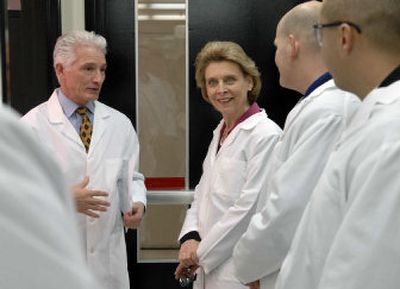Gregoire tours labs at HollisterStier

As she travels the state this week to push elements of her upcoming budget, Gov. Chris Gregoire has spent time in a children’s hospital in Seattle to emphasize the need for expanded child health coverage.
She’s talked to middle school students in Bellingham to emphasize education.
And, she’s watched a technician pull the venom sacs out of dead bees in Spokane to emphasize the need for “Innovation Zones.”
OK, the first two are pretty easy to understand. The third takes a bit of explaining.
Gregoire was visiting HollisterStier Laboratories Thursday to learn more about how the north Spokane operation has grown from 275 employees to about 425 in three years. Chief Executive Officer Tony Bonanzino explained that the company has a new, 26,000-square-foot facility under construction next door, with half that space devoted to new labs.
It’s growing quickly as it manufactures everything from anthrax and plague vaccines to cancer drugs under contracts with companies that develop the drugs but need someone else to produce them. It recently cleared out space in a warehouse to set up a one-of-a-kind machine that assembles a new “pen” that provides synthetic insulin injections for diabetic patients, and built a huge refrigeration unit for storage.
But the operation in the North Side facility that fascinated the governor most was a room where venom is taken from dead yellow jackets and put in vials for later processing that creates medicine to treat allergic reactions to stings. She watched as a technician with long tweezers deftly took out the venom sacs, one bee at a time. They go through thousands of bees a day.
“Do you get paid by the bee?” Gregoire asked a technician, who smiled and shook her head no.
Gregoire later told a group of HollisterStier employees the type of work the company does positions the state well for one of the big pushes of the 21st century: global health concerns. Seattle has some wonderful research facilities, but it takes manufacturing operations like HollisterStier to turn that research into products and jobs, she said.
“Nothing on the West Side compares with what you do here,” she said.
She’s asking the Legislature to set aside five $1 million grants this year to different communities willing to establish Innovation Zones, where new companies can locate and benefit from the synergy of being in close proximity and exchanging ideas. Spokane should definitely apply for an Innovation Zone designation if the Legislature approves the plan for health science businesses like HollisterStier, she said.
The state money could be used for infrastructure, which policy adviser Marc Baldwin said could be roads and sewers, high-speed Internet facilities or even central conference facilities. Local governments could help by offering tax deferrals.
Bonanzino said HollisterStier already benefits from being in a Community Empowerment Zone, which allows it to defer taxes on manufacturing equipment.